Disease Prevention and Management of Obesity in Brunswick East
VerifiedAdded on 2021/01/01
|13
|3974
|482
Report
AI Summary
This report provides a comprehensive analysis of obesity prevention and management strategies within the Brunswick East community, focusing on the local primary school and surrounding demographics. It examines the etiology and epidemiology of obesity, considering lifestyle, genetic factors, physical inactivity, and medication. The report details interventions, including the 5A approach (Assess, Ask, Advise, Assist, Arrange) and awareness campaigns, and discusses communication strategies. It also presents an evaluation framework for managing and preventing obesity, emphasizing the importance of community involvement and healthy lifestyle choices. The report highlights the need for early intervention, community support, and the promotion of physical activity to address the rising rates of obesity and related non-communicable diseases within the Brunswick East area. The report also underscores the role of schools and families in fostering healthy habits and the importance of multidisciplinary approaches, including nutritional guidance and psychological support, to facilitate effective weight management and long-term health outcomes. The report is contributed by a student to be published on the website Desklib. Desklib is a platform which provides all the necessary AI based study tools for students.
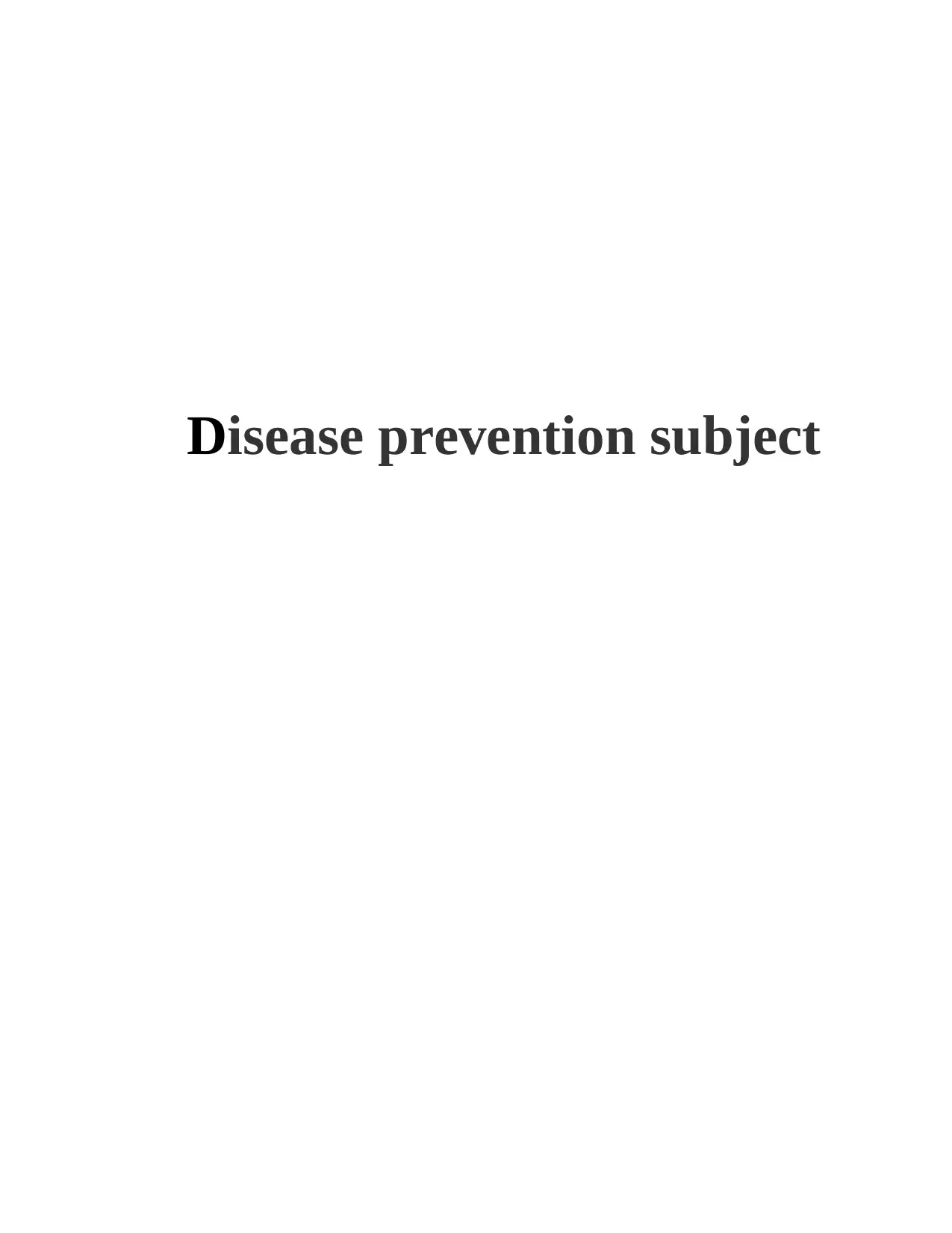
Disease prevention subject
Paraphrase This Document
Need a fresh take? Get an instant paraphrase of this document with our AI Paraphraser
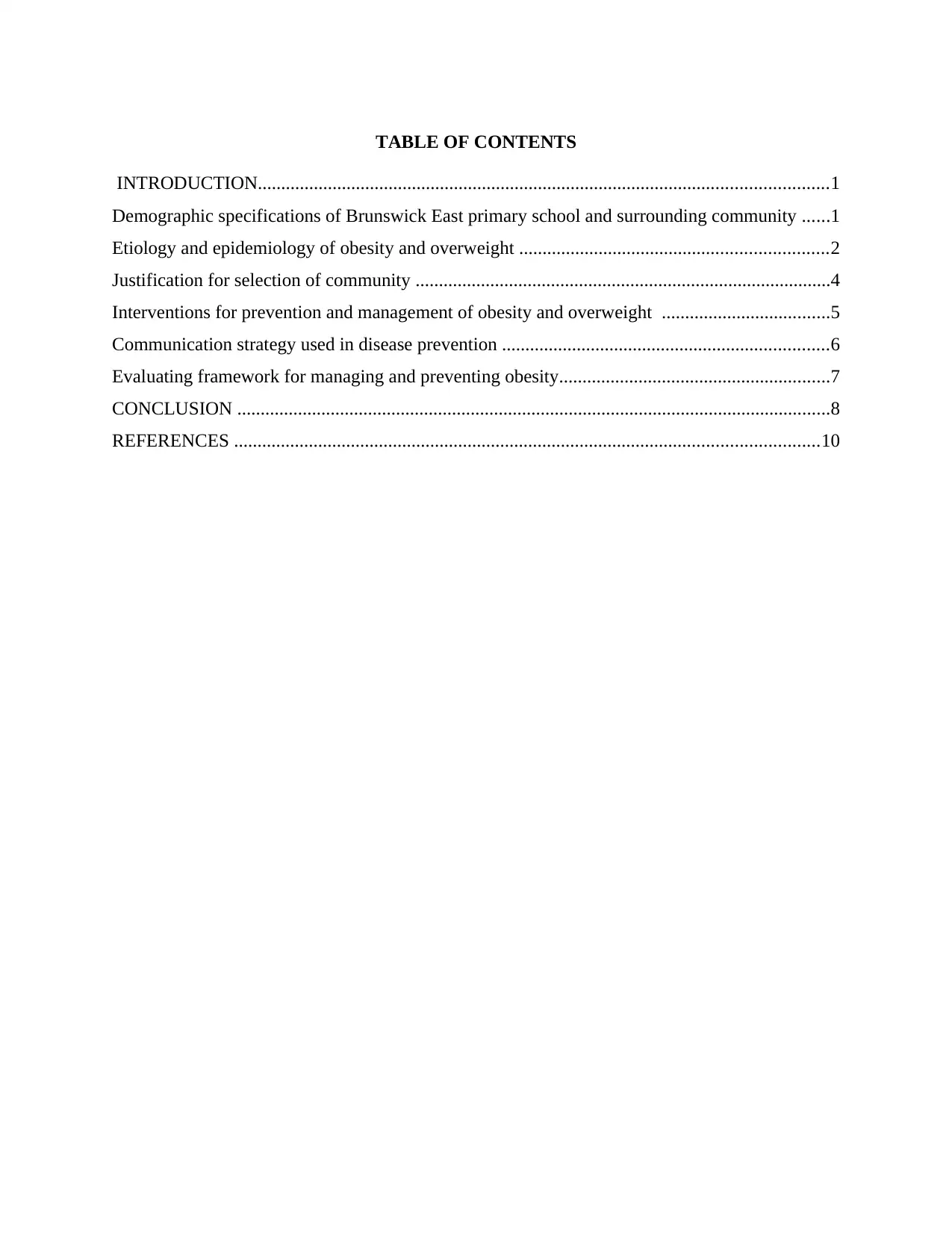
TABLE OF CONTENTS
INTRODUCTION..........................................................................................................................1
Demographic specifications of Brunswick East primary school and surrounding community ......1
Etiology and epidemiology of obesity and overweight ..................................................................2
Justification for selection of community .........................................................................................4
Interventions for prevention and management of obesity and overweight ....................................5
Communication strategy used in disease prevention ......................................................................6
Evaluating framework for managing and preventing obesity..........................................................7
CONCLUSION ...............................................................................................................................8
REFERENCES .............................................................................................................................10
INTRODUCTION..........................................................................................................................1
Demographic specifications of Brunswick East primary school and surrounding community ......1
Etiology and epidemiology of obesity and overweight ..................................................................2
Justification for selection of community .........................................................................................4
Interventions for prevention and management of obesity and overweight ....................................5
Communication strategy used in disease prevention ......................................................................6
Evaluating framework for managing and preventing obesity..........................................................7
CONCLUSION ...............................................................................................................................8
REFERENCES .............................................................................................................................10
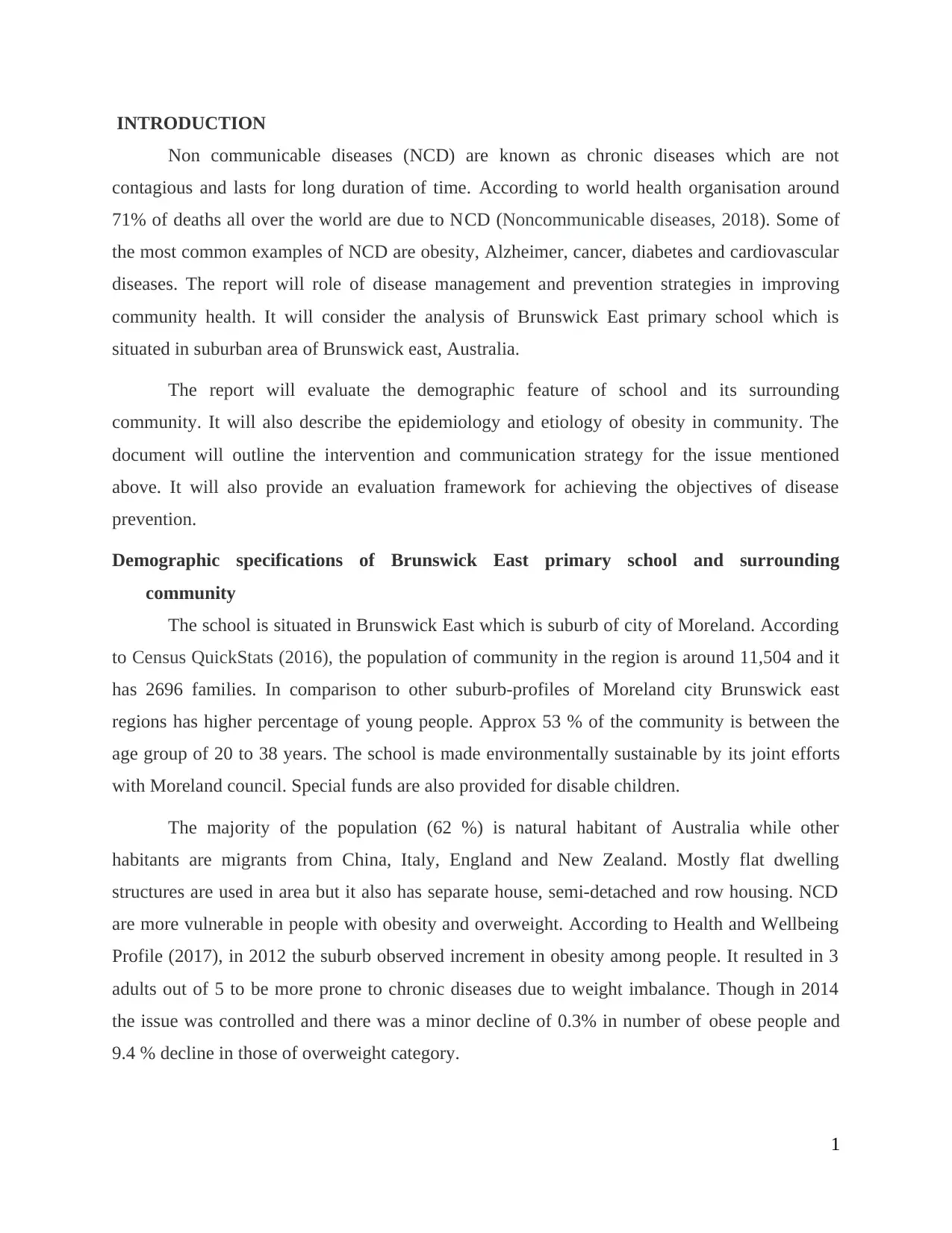
INTRODUCTION
Non communicable diseases (NCD) are known as chronic diseases which are not
contagious and lasts for long duration of time. According to world health organisation around
71% of deaths all over the world are due to NCD (Noncommunicable diseases, 2018). Some of
the most common examples of NCD are obesity, Alzheimer, cancer, diabetes and cardiovascular
diseases. The report will role of disease management and prevention strategies in improving
community health. It will consider the analysis of Brunswick East primary school which is
situated in suburban area of Brunswick east, Australia.
The report will evaluate the demographic feature of school and its surrounding
community. It will also describe the epidemiology and etiology of obesity in community. The
document will outline the intervention and communication strategy for the issue mentioned
above. It will also provide an evaluation framework for achieving the objectives of disease
prevention.
Demographic specifications of Brunswick East primary school and surrounding
community
The school is situated in Brunswick East which is suburb of city of Moreland. According
to Census QuickStats (2016), the population of community in the region is around 11,504 and it
has 2696 families. In comparison to other suburb-profiles of Moreland city Brunswick east
regions has higher percentage of young people. Approx 53 % of the community is between the
age group of 20 to 38 years. The school is made environmentally sustainable by its joint efforts
with Moreland council. Special funds are also provided for disable children.
The majority of the population (62 %) is natural habitant of Australia while other
habitants are migrants from China, Italy, England and New Zealand. Mostly flat dwelling
structures are used in area but it also has separate house, semi-detached and row housing. NCD
are more vulnerable in people with obesity and overweight. According to Health and Wellbeing
Profile (2017), in 2012 the suburb observed increment in obesity among people. It resulted in 3
adults out of 5 to be more prone to chronic diseases due to weight imbalance. Though in 2014
the issue was controlled and there was a minor decline of 0.3% in number of obese people and
9.4 % decline in those of overweight category.
1
Non communicable diseases (NCD) are known as chronic diseases which are not
contagious and lasts for long duration of time. According to world health organisation around
71% of deaths all over the world are due to NCD (Noncommunicable diseases, 2018). Some of
the most common examples of NCD are obesity, Alzheimer, cancer, diabetes and cardiovascular
diseases. The report will role of disease management and prevention strategies in improving
community health. It will consider the analysis of Brunswick East primary school which is
situated in suburban area of Brunswick east, Australia.
The report will evaluate the demographic feature of school and its surrounding
community. It will also describe the epidemiology and etiology of obesity in community. The
document will outline the intervention and communication strategy for the issue mentioned
above. It will also provide an evaluation framework for achieving the objectives of disease
prevention.
Demographic specifications of Brunswick East primary school and surrounding
community
The school is situated in Brunswick East which is suburb of city of Moreland. According
to Census QuickStats (2016), the population of community in the region is around 11,504 and it
has 2696 families. In comparison to other suburb-profiles of Moreland city Brunswick east
regions has higher percentage of young people. Approx 53 % of the community is between the
age group of 20 to 38 years. The school is made environmentally sustainable by its joint efforts
with Moreland council. Special funds are also provided for disable children.
The majority of the population (62 %) is natural habitant of Australia while other
habitants are migrants from China, Italy, England and New Zealand. Mostly flat dwelling
structures are used in area but it also has separate house, semi-detached and row housing. NCD
are more vulnerable in people with obesity and overweight. According to Health and Wellbeing
Profile (2017), in 2012 the suburb observed increment in obesity among people. It resulted in 3
adults out of 5 to be more prone to chronic diseases due to weight imbalance. Though in 2014
the issue was controlled and there was a minor decline of 0.3% in number of obese people and
9.4 % decline in those of overweight category.
1
⊘ This is a preview!⊘
Do you want full access?
Subscribe today to unlock all pages.

Trusted by 1+ million students worldwide
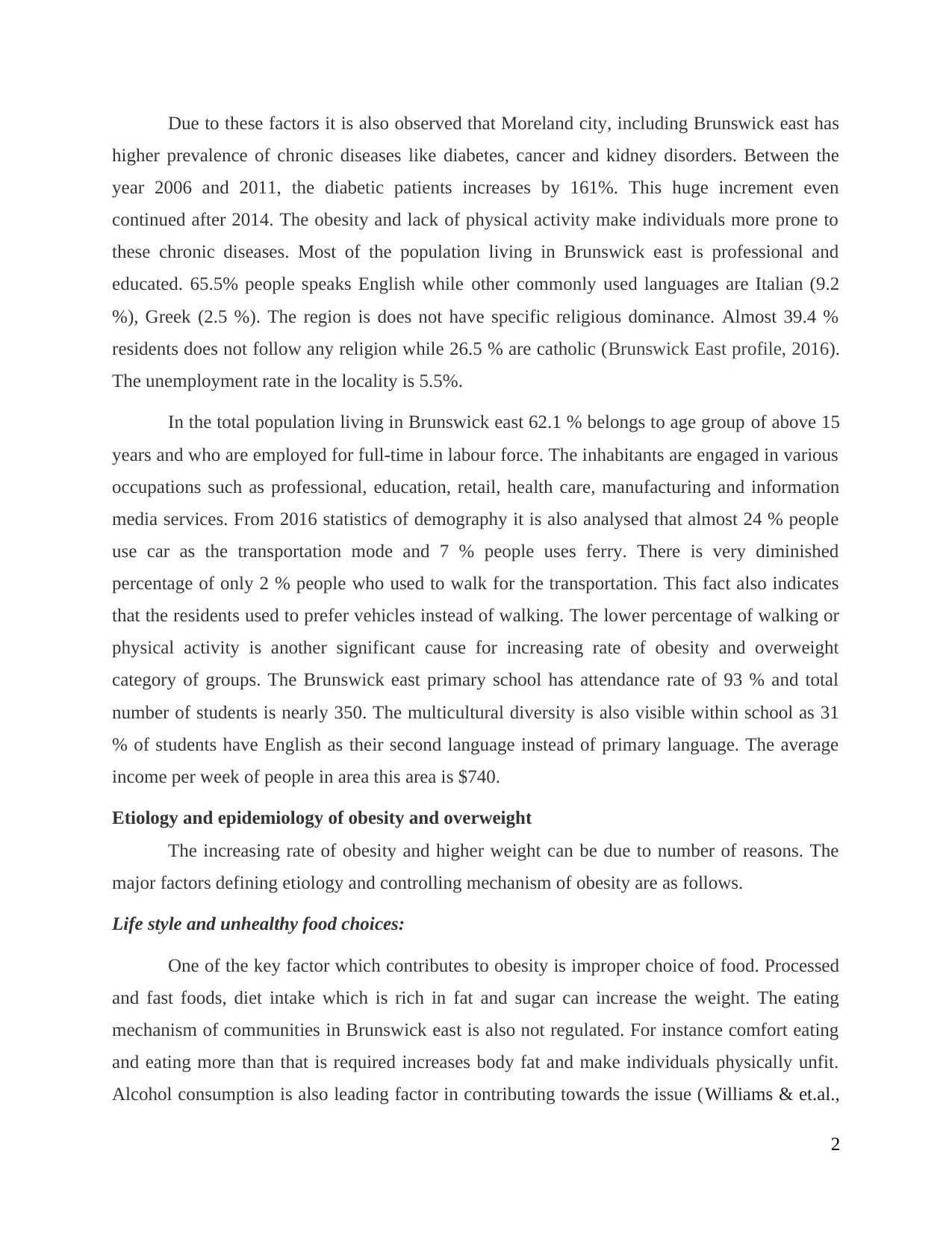
Due to these factors it is also observed that Moreland city, including Brunswick east has
higher prevalence of chronic diseases like diabetes, cancer and kidney disorders. Between the
year 2006 and 2011, the diabetic patients increases by 161%. This huge increment even
continued after 2014. The obesity and lack of physical activity make individuals more prone to
these chronic diseases. Most of the population living in Brunswick east is professional and
educated. 65.5% people speaks English while other commonly used languages are Italian (9.2
%), Greek (2.5 %). The region is does not have specific religious dominance. Almost 39.4 %
residents does not follow any religion while 26.5 % are catholic (Brunswick East profile, 2016).
The unemployment rate in the locality is 5.5%.
In the total population living in Brunswick east 62.1 % belongs to age group of above 15
years and who are employed for full-time in labour force. The inhabitants are engaged in various
occupations such as professional, education, retail, health care, manufacturing and information
media services. From 2016 statistics of demography it is also analysed that almost 24 % people
use car as the transportation mode and 7 % people uses ferry. There is very diminished
percentage of only 2 % people who used to walk for the transportation. This fact also indicates
that the residents used to prefer vehicles instead of walking. The lower percentage of walking or
physical activity is another significant cause for increasing rate of obesity and overweight
category of groups. The Brunswick east primary school has attendance rate of 93 % and total
number of students is nearly 350. The multicultural diversity is also visible within school as 31
% of students have English as their second language instead of primary language. The average
income per week of people in area this area is $740.
Etiology and epidemiology of obesity and overweight
The increasing rate of obesity and higher weight can be due to number of reasons. The
major factors defining etiology and controlling mechanism of obesity are as follows.
Life style and unhealthy food choices:
One of the key factor which contributes to obesity is improper choice of food. Processed
and fast foods, diet intake which is rich in fat and sugar can increase the weight. The eating
mechanism of communities in Brunswick east is also not regulated. For instance comfort eating
and eating more than that is required increases body fat and make individuals physically unfit.
Alcohol consumption is also leading factor in contributing towards the issue (Williams & et.al.,
2
higher prevalence of chronic diseases like diabetes, cancer and kidney disorders. Between the
year 2006 and 2011, the diabetic patients increases by 161%. This huge increment even
continued after 2014. The obesity and lack of physical activity make individuals more prone to
these chronic diseases. Most of the population living in Brunswick east is professional and
educated. 65.5% people speaks English while other commonly used languages are Italian (9.2
%), Greek (2.5 %). The region is does not have specific religious dominance. Almost 39.4 %
residents does not follow any religion while 26.5 % are catholic (Brunswick East profile, 2016).
The unemployment rate in the locality is 5.5%.
In the total population living in Brunswick east 62.1 % belongs to age group of above 15
years and who are employed for full-time in labour force. The inhabitants are engaged in various
occupations such as professional, education, retail, health care, manufacturing and information
media services. From 2016 statistics of demography it is also analysed that almost 24 % people
use car as the transportation mode and 7 % people uses ferry. There is very diminished
percentage of only 2 % people who used to walk for the transportation. This fact also indicates
that the residents used to prefer vehicles instead of walking. The lower percentage of walking or
physical activity is another significant cause for increasing rate of obesity and overweight
category of groups. The Brunswick east primary school has attendance rate of 93 % and total
number of students is nearly 350. The multicultural diversity is also visible within school as 31
% of students have English as their second language instead of primary language. The average
income per week of people in area this area is $740.
Etiology and epidemiology of obesity and overweight
The increasing rate of obesity and higher weight can be due to number of reasons. The
major factors defining etiology and controlling mechanism of obesity are as follows.
Life style and unhealthy food choices:
One of the key factor which contributes to obesity is improper choice of food. Processed
and fast foods, diet intake which is rich in fat and sugar can increase the weight. The eating
mechanism of communities in Brunswick east is also not regulated. For instance comfort eating
and eating more than that is required increases body fat and make individuals physically unfit.
Alcohol consumption is also leading factor in contributing towards the issue (Williams & et.al.,
2
Paraphrase This Document
Need a fresh take? Get an instant paraphrase of this document with our AI Paraphraser
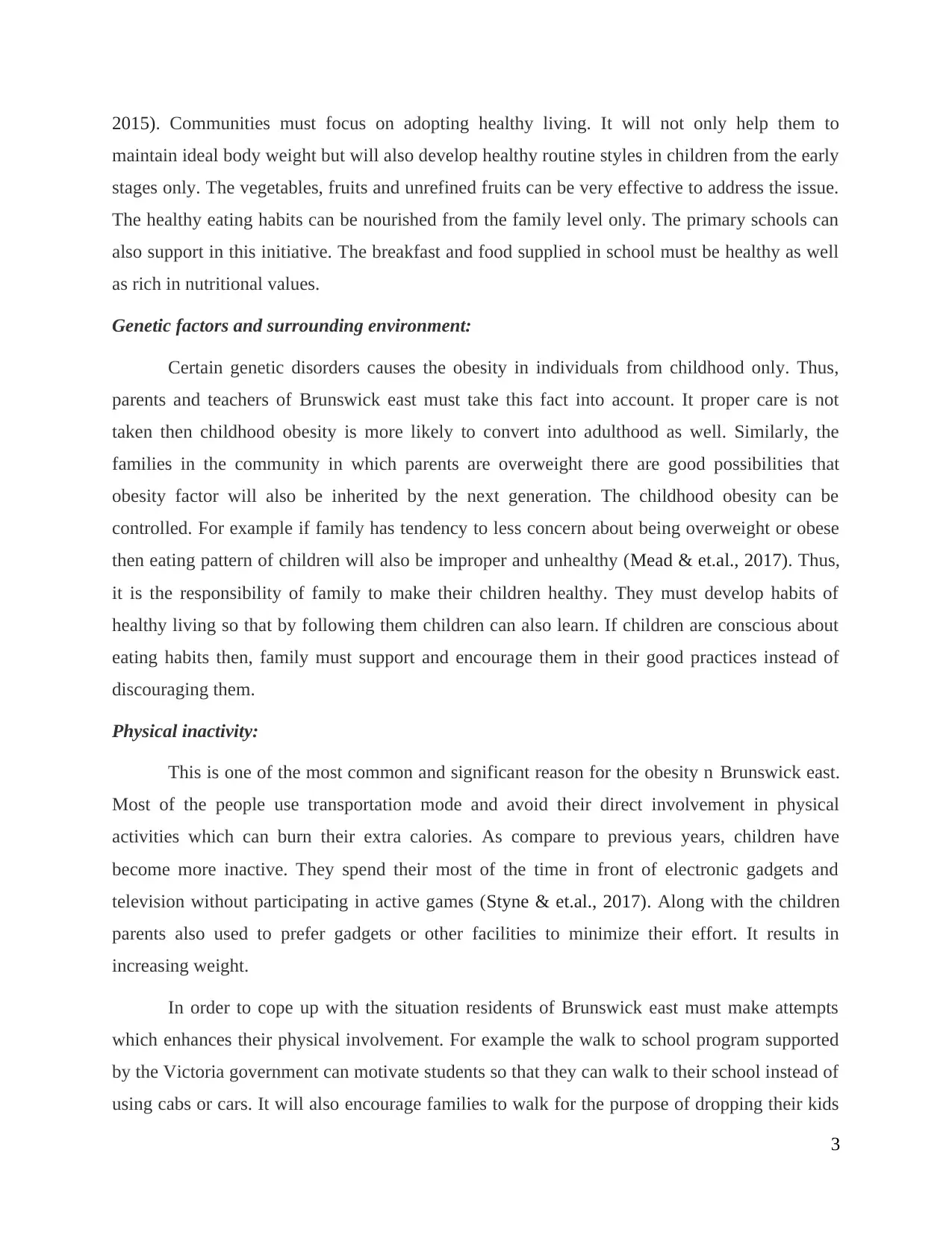
2015). Communities must focus on adopting healthy living. It will not only help them to
maintain ideal body weight but will also develop healthy routine styles in children from the early
stages only. The vegetables, fruits and unrefined fruits can be very effective to address the issue.
The healthy eating habits can be nourished from the family level only. The primary schools can
also support in this initiative. The breakfast and food supplied in school must be healthy as well
as rich in nutritional values.
Genetic factors and surrounding environment:
Certain genetic disorders causes the obesity in individuals from childhood only. Thus,
parents and teachers of Brunswick east must take this fact into account. It proper care is not
taken then childhood obesity is more likely to convert into adulthood as well. Similarly, the
families in the community in which parents are overweight there are good possibilities that
obesity factor will also be inherited by the next generation. The childhood obesity can be
controlled. For example if family has tendency to less concern about being overweight or obese
then eating pattern of children will also be improper and unhealthy (Mead & et.al., 2017). Thus,
it is the responsibility of family to make their children healthy. They must develop habits of
healthy living so that by following them children can also learn. If children are conscious about
eating habits then, family must support and encourage them in their good practices instead of
discouraging them.
Physical inactivity:
This is one of the most common and significant reason for the obesity n Brunswick east.
Most of the people use transportation mode and avoid their direct involvement in physical
activities which can burn their extra calories. As compare to previous years, children have
become more inactive. They spend their most of the time in front of electronic gadgets and
television without participating in active games (Styne & et.al., 2017). Along with the children
parents also used to prefer gadgets or other facilities to minimize their effort. It results in
increasing weight.
In order to cope up with the situation residents of Brunswick east must make attempts
which enhances their physical involvement. For example the walk to school program supported
by the Victoria government can motivate students so that they can walk to their school instead of
using cabs or cars. It will also encourage families to walk for the purpose of dropping their kids
3
maintain ideal body weight but will also develop healthy routine styles in children from the early
stages only. The vegetables, fruits and unrefined fruits can be very effective to address the issue.
The healthy eating habits can be nourished from the family level only. The primary schools can
also support in this initiative. The breakfast and food supplied in school must be healthy as well
as rich in nutritional values.
Genetic factors and surrounding environment:
Certain genetic disorders causes the obesity in individuals from childhood only. Thus,
parents and teachers of Brunswick east must take this fact into account. It proper care is not
taken then childhood obesity is more likely to convert into adulthood as well. Similarly, the
families in the community in which parents are overweight there are good possibilities that
obesity factor will also be inherited by the next generation. The childhood obesity can be
controlled. For example if family has tendency to less concern about being overweight or obese
then eating pattern of children will also be improper and unhealthy (Mead & et.al., 2017). Thus,
it is the responsibility of family to make their children healthy. They must develop habits of
healthy living so that by following them children can also learn. If children are conscious about
eating habits then, family must support and encourage them in their good practices instead of
discouraging them.
Physical inactivity:
This is one of the most common and significant reason for the obesity n Brunswick east.
Most of the people use transportation mode and avoid their direct involvement in physical
activities which can burn their extra calories. As compare to previous years, children have
become more inactive. They spend their most of the time in front of electronic gadgets and
television without participating in active games (Styne & et.al., 2017). Along with the children
parents also used to prefer gadgets or other facilities to minimize their effort. It results in
increasing weight.
In order to cope up with the situation residents of Brunswick east must make attempts
which enhances their physical involvement. For example the walk to school program supported
by the Victoria government can motivate students so that they can walk to their school instead of
using cabs or cars. It will also encourage families to walk for the purpose of dropping their kids
3
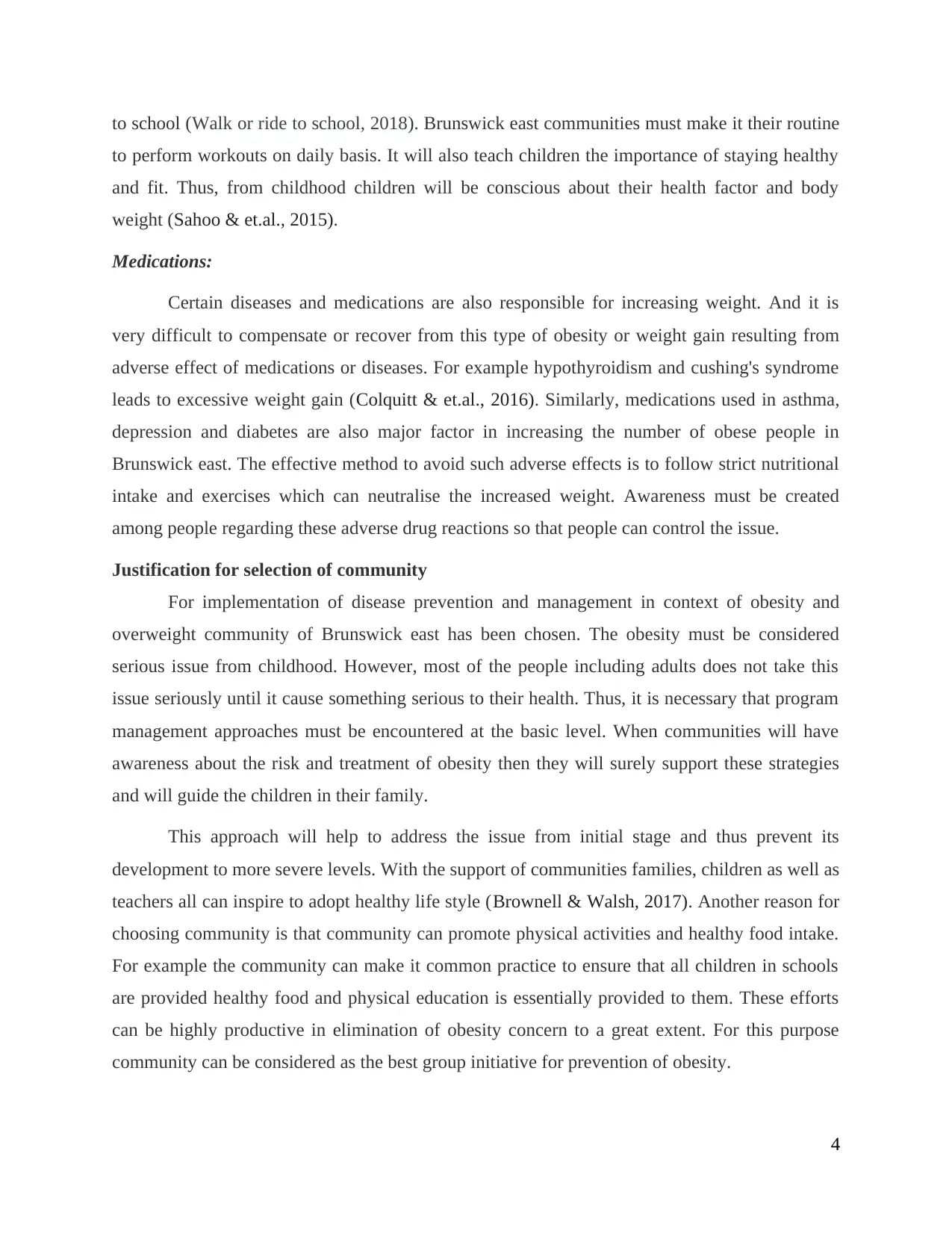
to school (Walk or ride to school, 2018). Brunswick east communities must make it their routine
to perform workouts on daily basis. It will also teach children the importance of staying healthy
and fit. Thus, from childhood children will be conscious about their health factor and body
weight (Sahoo & et.al., 2015).
Medications:
Certain diseases and medications are also responsible for increasing weight. And it is
very difficult to compensate or recover from this type of obesity or weight gain resulting from
adverse effect of medications or diseases. For example hypothyroidism and cushing's syndrome
leads to excessive weight gain (Colquitt & et.al., 2016). Similarly, medications used in asthma,
depression and diabetes are also major factor in increasing the number of obese people in
Brunswick east. The effective method to avoid such adverse effects is to follow strict nutritional
intake and exercises which can neutralise the increased weight. Awareness must be created
among people regarding these adverse drug reactions so that people can control the issue.
Justification for selection of community
For implementation of disease prevention and management in context of obesity and
overweight community of Brunswick east has been chosen. The obesity must be considered
serious issue from childhood. However, most of the people including adults does not take this
issue seriously until it cause something serious to their health. Thus, it is necessary that program
management approaches must be encountered at the basic level. When communities will have
awareness about the risk and treatment of obesity then they will surely support these strategies
and will guide the children in their family.
This approach will help to address the issue from initial stage and thus prevent its
development to more severe levels. With the support of communities families, children as well as
teachers all can inspire to adopt healthy life style (Brownell & Walsh, 2017). Another reason for
choosing community is that community can promote physical activities and healthy food intake.
For example the community can make it common practice to ensure that all children in schools
are provided healthy food and physical education is essentially provided to them. These efforts
can be highly productive in elimination of obesity concern to a great extent. For this purpose
community can be considered as the best group initiative for prevention of obesity.
4
to perform workouts on daily basis. It will also teach children the importance of staying healthy
and fit. Thus, from childhood children will be conscious about their health factor and body
weight (Sahoo & et.al., 2015).
Medications:
Certain diseases and medications are also responsible for increasing weight. And it is
very difficult to compensate or recover from this type of obesity or weight gain resulting from
adverse effect of medications or diseases. For example hypothyroidism and cushing's syndrome
leads to excessive weight gain (Colquitt & et.al., 2016). Similarly, medications used in asthma,
depression and diabetes are also major factor in increasing the number of obese people in
Brunswick east. The effective method to avoid such adverse effects is to follow strict nutritional
intake and exercises which can neutralise the increased weight. Awareness must be created
among people regarding these adverse drug reactions so that people can control the issue.
Justification for selection of community
For implementation of disease prevention and management in context of obesity and
overweight community of Brunswick east has been chosen. The obesity must be considered
serious issue from childhood. However, most of the people including adults does not take this
issue seriously until it cause something serious to their health. Thus, it is necessary that program
management approaches must be encountered at the basic level. When communities will have
awareness about the risk and treatment of obesity then they will surely support these strategies
and will guide the children in their family.
This approach will help to address the issue from initial stage and thus prevent its
development to more severe levels. With the support of communities families, children as well as
teachers all can inspire to adopt healthy life style (Brownell & Walsh, 2017). Another reason for
choosing community is that community can promote physical activities and healthy food intake.
For example the community can make it common practice to ensure that all children in schools
are provided healthy food and physical education is essentially provided to them. These efforts
can be highly productive in elimination of obesity concern to a great extent. For this purpose
community can be considered as the best group initiative for prevention of obesity.
4
⊘ This is a preview!⊘
Do you want full access?
Subscribe today to unlock all pages.

Trusted by 1+ million students worldwide
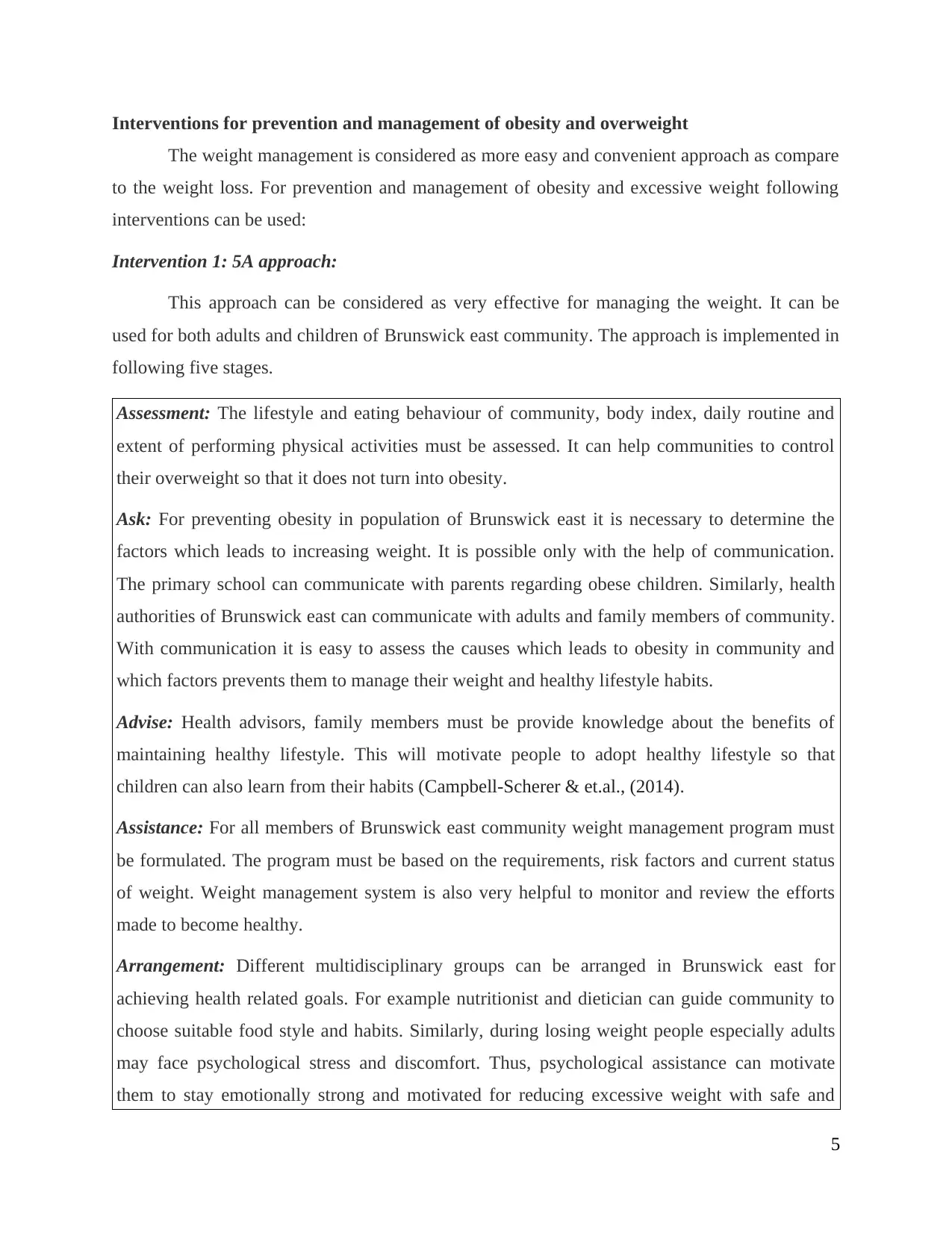
Interventions for prevention and management of obesity and overweight
The weight management is considered as more easy and convenient approach as compare
to the weight loss. For prevention and management of obesity and excessive weight following
interventions can be used:
Intervention 1: 5A approach:
This approach can be considered as very effective for managing the weight. It can be
used for both adults and children of Brunswick east community. The approach is implemented in
following five stages.
Assessment: The lifestyle and eating behaviour of community, body index, daily routine and
extent of performing physical activities must be assessed. It can help communities to control
their overweight so that it does not turn into obesity.
Ask: For preventing obesity in population of Brunswick east it is necessary to determine the
factors which leads to increasing weight. It is possible only with the help of communication.
The primary school can communicate with parents regarding obese children. Similarly, health
authorities of Brunswick east can communicate with adults and family members of community.
With communication it is easy to assess the causes which leads to obesity in community and
which factors prevents them to manage their weight and healthy lifestyle habits.
Advise: Health advisors, family members must be provide knowledge about the benefits of
maintaining healthy lifestyle. This will motivate people to adopt healthy lifestyle so that
children can also learn from their habits (Campbell-Scherer & et.al., (2014).
Assistance: For all members of Brunswick east community weight management program must
be formulated. The program must be based on the requirements, risk factors and current status
of weight. Weight management system is also very helpful to monitor and review the efforts
made to become healthy.
Arrangement: Different multidisciplinary groups can be arranged in Brunswick east for
achieving health related goals. For example nutritionist and dietician can guide community to
choose suitable food style and habits. Similarly, during losing weight people especially adults
may face psychological stress and discomfort. Thus, psychological assistance can motivate
them to stay emotionally strong and motivated for reducing excessive weight with safe and
5
The weight management is considered as more easy and convenient approach as compare
to the weight loss. For prevention and management of obesity and excessive weight following
interventions can be used:
Intervention 1: 5A approach:
This approach can be considered as very effective for managing the weight. It can be
used for both adults and children of Brunswick east community. The approach is implemented in
following five stages.
Assessment: The lifestyle and eating behaviour of community, body index, daily routine and
extent of performing physical activities must be assessed. It can help communities to control
their overweight so that it does not turn into obesity.
Ask: For preventing obesity in population of Brunswick east it is necessary to determine the
factors which leads to increasing weight. It is possible only with the help of communication.
The primary school can communicate with parents regarding obese children. Similarly, health
authorities of Brunswick east can communicate with adults and family members of community.
With communication it is easy to assess the causes which leads to obesity in community and
which factors prevents them to manage their weight and healthy lifestyle habits.
Advise: Health advisors, family members must be provide knowledge about the benefits of
maintaining healthy lifestyle. This will motivate people to adopt healthy lifestyle so that
children can also learn from their habits (Campbell-Scherer & et.al., (2014).
Assistance: For all members of Brunswick east community weight management program must
be formulated. The program must be based on the requirements, risk factors and current status
of weight. Weight management system is also very helpful to monitor and review the efforts
made to become healthy.
Arrangement: Different multidisciplinary groups can be arranged in Brunswick east for
achieving health related goals. For example nutritionist and dietician can guide community to
choose suitable food style and habits. Similarly, during losing weight people especially adults
may face psychological stress and discomfort. Thus, psychological assistance can motivate
them to stay emotionally strong and motivated for reducing excessive weight with safe and
5
Paraphrase This Document
Need a fresh take? Get an instant paraphrase of this document with our AI Paraphraser
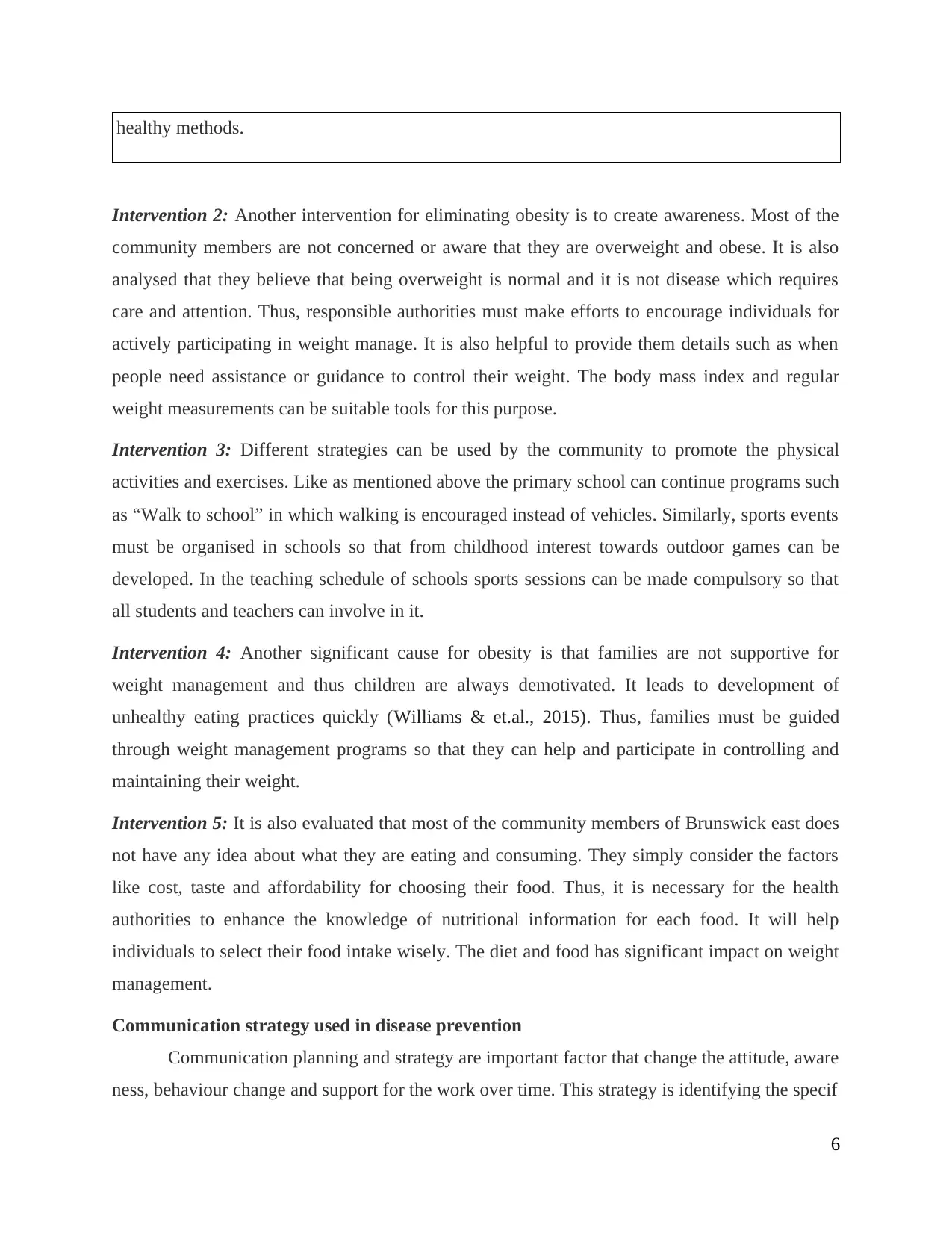
healthy methods.
Intervention 2: Another intervention for eliminating obesity is to create awareness. Most of the
community members are not concerned or aware that they are overweight and obese. It is also
analysed that they believe that being overweight is normal and it is not disease which requires
care and attention. Thus, responsible authorities must make efforts to encourage individuals for
actively participating in weight manage. It is also helpful to provide them details such as when
people need assistance or guidance to control their weight. The body mass index and regular
weight measurements can be suitable tools for this purpose.
Intervention 3: Different strategies can be used by the community to promote the physical
activities and exercises. Like as mentioned above the primary school can continue programs such
as “Walk to school” in which walking is encouraged instead of vehicles. Similarly, sports events
must be organised in schools so that from childhood interest towards outdoor games can be
developed. In the teaching schedule of schools sports sessions can be made compulsory so that
all students and teachers can involve in it.
Intervention 4: Another significant cause for obesity is that families are not supportive for
weight management and thus children are always demotivated. It leads to development of
unhealthy eating practices quickly (Williams & et.al., 2015). Thus, families must be guided
through weight management programs so that they can help and participate in controlling and
maintaining their weight.
Intervention 5: It is also evaluated that most of the community members of Brunswick east does
not have any idea about what they are eating and consuming. They simply consider the factors
like cost, taste and affordability for choosing their food. Thus, it is necessary for the health
authorities to enhance the knowledge of nutritional information for each food. It will help
individuals to select their food intake wisely. The diet and food has significant impact on weight
management.
Communication strategy used in disease prevention
Communication planning and strategy are important factor that change the attitude, aware
ness, behaviour change and support for the work over time. This strategy is identifying the specif
6
Intervention 2: Another intervention for eliminating obesity is to create awareness. Most of the
community members are not concerned or aware that they are overweight and obese. It is also
analysed that they believe that being overweight is normal and it is not disease which requires
care and attention. Thus, responsible authorities must make efforts to encourage individuals for
actively participating in weight manage. It is also helpful to provide them details such as when
people need assistance or guidance to control their weight. The body mass index and regular
weight measurements can be suitable tools for this purpose.
Intervention 3: Different strategies can be used by the community to promote the physical
activities and exercises. Like as mentioned above the primary school can continue programs such
as “Walk to school” in which walking is encouraged instead of vehicles. Similarly, sports events
must be organised in schools so that from childhood interest towards outdoor games can be
developed. In the teaching schedule of schools sports sessions can be made compulsory so that
all students and teachers can involve in it.
Intervention 4: Another significant cause for obesity is that families are not supportive for
weight management and thus children are always demotivated. It leads to development of
unhealthy eating practices quickly (Williams & et.al., 2015). Thus, families must be guided
through weight management programs so that they can help and participate in controlling and
maintaining their weight.
Intervention 5: It is also evaluated that most of the community members of Brunswick east does
not have any idea about what they are eating and consuming. They simply consider the factors
like cost, taste and affordability for choosing their food. Thus, it is necessary for the health
authorities to enhance the knowledge of nutritional information for each food. It will help
individuals to select their food intake wisely. The diet and food has significant impact on weight
management.
Communication strategy used in disease prevention
Communication planning and strategy are important factor that change the attitude, aware
ness, behaviour change and support for the work over time. This strategy is identifying the specif
6
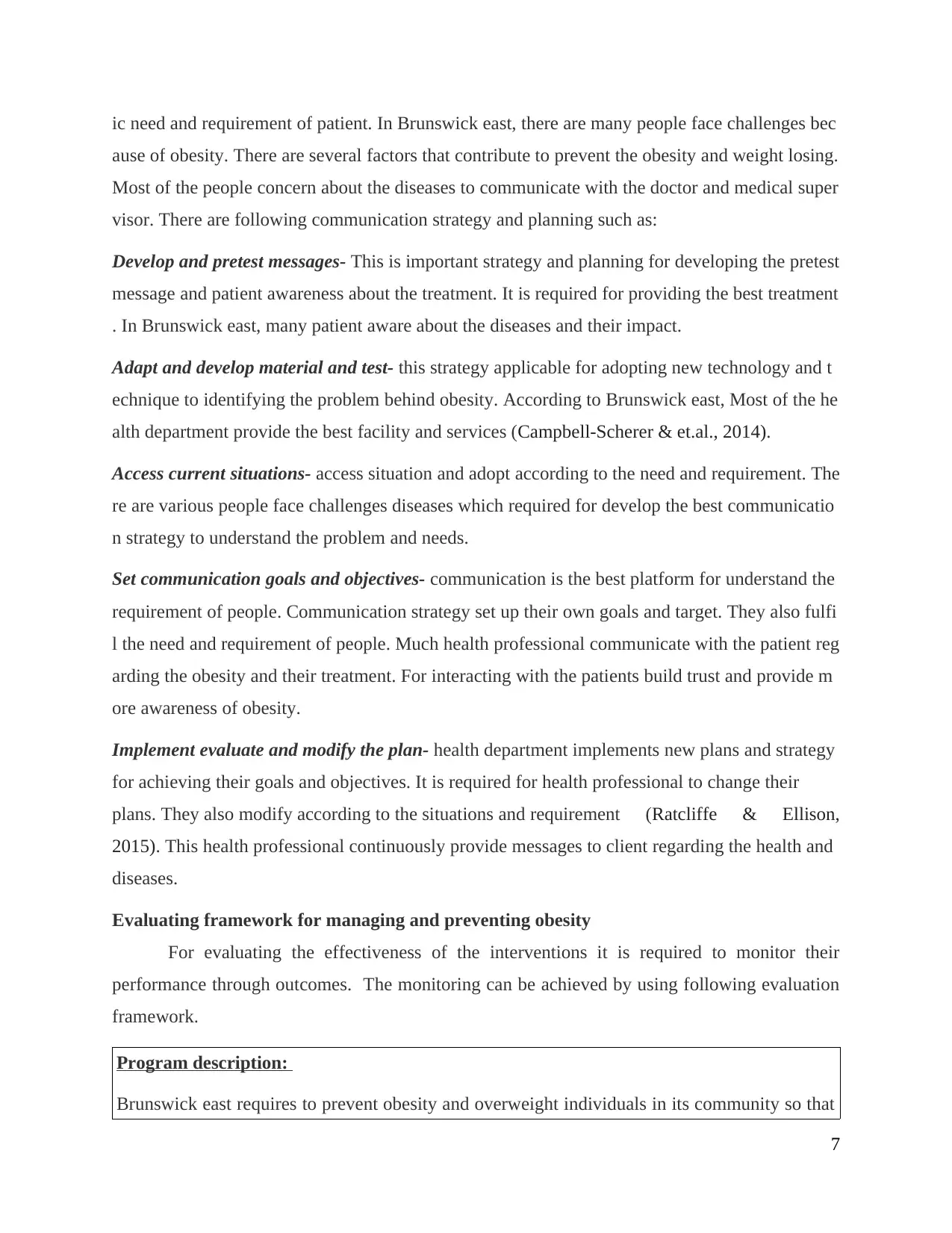
ic need and requirement of patient. In Brunswick east, there are many people face challenges bec
ause of obesity. There are several factors that contribute to prevent the obesity and weight losing.
Most of the people concern about the diseases to communicate with the doctor and medical super
visor. There are following communication strategy and planning such as:
Develop and pretest messages- This is important strategy and planning for developing the pretest
message and patient awareness about the treatment. It is required for providing the best treatment
. In Brunswick east, many patient aware about the diseases and their impact.
Adapt and develop material and test- this strategy applicable for adopting new technology and t
echnique to identifying the problem behind obesity. According to Brunswick east, Most of the he
alth department provide the best facility and services (Campbell-Scherer & et.al., 2014).
Access current situations- access situation and adopt according to the need and requirement. The
re are various people face challenges diseases which required for develop the best communicatio
n strategy to understand the problem and needs.
Set communication goals and objectives- communication is the best platform for understand the
requirement of people. Communication strategy set up their own goals and target. They also fulfi
l the need and requirement of people. Much health professional communicate with the patient reg
arding the obesity and their treatment. For interacting with the patients build trust and provide m
ore awareness of obesity.
Implement evaluate and modify the plan- health department implements new plans and strategy
for achieving their goals and objectives. It is required for health professional to change their
plans. They also modify according to the situations and requirement (Ratcliffe & Ellison,
2015). This health professional continuously provide messages to client regarding the health and
diseases.
Evaluating framework for managing and preventing obesity
For evaluating the effectiveness of the interventions it is required to monitor their
performance through outcomes. The monitoring can be achieved by using following evaluation
framework.
Program description:
Brunswick east requires to prevent obesity and overweight individuals in its community so that
7
ause of obesity. There are several factors that contribute to prevent the obesity and weight losing.
Most of the people concern about the diseases to communicate with the doctor and medical super
visor. There are following communication strategy and planning such as:
Develop and pretest messages- This is important strategy and planning for developing the pretest
message and patient awareness about the treatment. It is required for providing the best treatment
. In Brunswick east, many patient aware about the diseases and their impact.
Adapt and develop material and test- this strategy applicable for adopting new technology and t
echnique to identifying the problem behind obesity. According to Brunswick east, Most of the he
alth department provide the best facility and services (Campbell-Scherer & et.al., 2014).
Access current situations- access situation and adopt according to the need and requirement. The
re are various people face challenges diseases which required for develop the best communicatio
n strategy to understand the problem and needs.
Set communication goals and objectives- communication is the best platform for understand the
requirement of people. Communication strategy set up their own goals and target. They also fulfi
l the need and requirement of people. Much health professional communicate with the patient reg
arding the obesity and their treatment. For interacting with the patients build trust and provide m
ore awareness of obesity.
Implement evaluate and modify the plan- health department implements new plans and strategy
for achieving their goals and objectives. It is required for health professional to change their
plans. They also modify according to the situations and requirement (Ratcliffe & Ellison,
2015). This health professional continuously provide messages to client regarding the health and
diseases.
Evaluating framework for managing and preventing obesity
For evaluating the effectiveness of the interventions it is required to monitor their
performance through outcomes. The monitoring can be achieved by using following evaluation
framework.
Program description:
Brunswick east requires to prevent obesity and overweight individuals in its community so that
7
⊘ This is a preview!⊘
Do you want full access?
Subscribe today to unlock all pages.

Trusted by 1+ million students worldwide
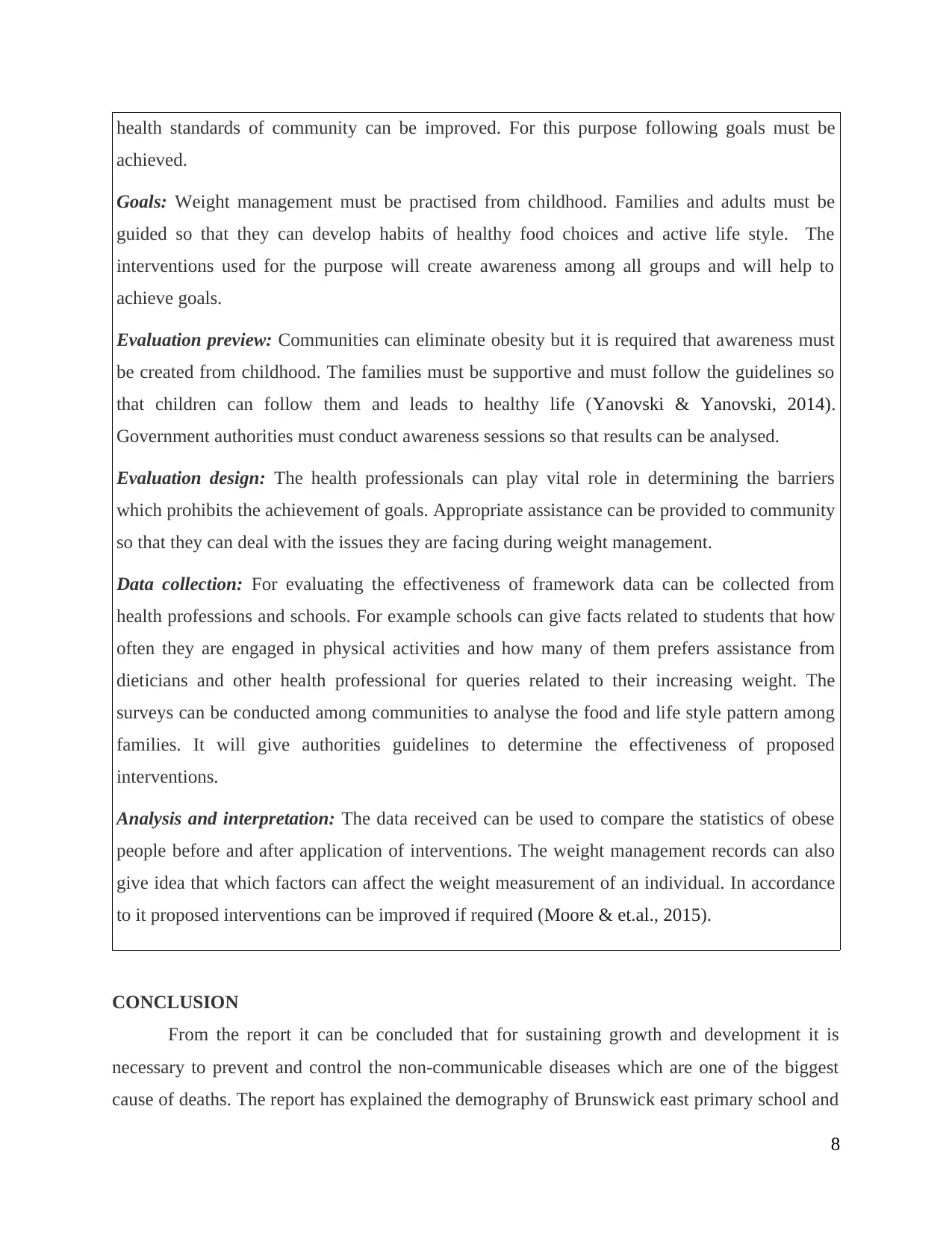
health standards of community can be improved. For this purpose following goals must be
achieved.
Goals: Weight management must be practised from childhood. Families and adults must be
guided so that they can develop habits of healthy food choices and active life style. The
interventions used for the purpose will create awareness among all groups and will help to
achieve goals.
Evaluation preview: Communities can eliminate obesity but it is required that awareness must
be created from childhood. The families must be supportive and must follow the guidelines so
that children can follow them and leads to healthy life (Yanovski & Yanovski, 2014).
Government authorities must conduct awareness sessions so that results can be analysed.
Evaluation design: The health professionals can play vital role in determining the barriers
which prohibits the achievement of goals. Appropriate assistance can be provided to community
so that they can deal with the issues they are facing during weight management.
Data collection: For evaluating the effectiveness of framework data can be collected from
health professions and schools. For example schools can give facts related to students that how
often they are engaged in physical activities and how many of them prefers assistance from
dieticians and other health professional for queries related to their increasing weight. The
surveys can be conducted among communities to analyse the food and life style pattern among
families. It will give authorities guidelines to determine the effectiveness of proposed
interventions.
Analysis and interpretation: The data received can be used to compare the statistics of obese
people before and after application of interventions. The weight management records can also
give idea that which factors can affect the weight measurement of an individual. In accordance
to it proposed interventions can be improved if required (Moore & et.al., 2015).
CONCLUSION
From the report it can be concluded that for sustaining growth and development it is
necessary to prevent and control the non-communicable diseases which are one of the biggest
cause of deaths. The report has explained the demography of Brunswick east primary school and
8
achieved.
Goals: Weight management must be practised from childhood. Families and adults must be
guided so that they can develop habits of healthy food choices and active life style. The
interventions used for the purpose will create awareness among all groups and will help to
achieve goals.
Evaluation preview: Communities can eliminate obesity but it is required that awareness must
be created from childhood. The families must be supportive and must follow the guidelines so
that children can follow them and leads to healthy life (Yanovski & Yanovski, 2014).
Government authorities must conduct awareness sessions so that results can be analysed.
Evaluation design: The health professionals can play vital role in determining the barriers
which prohibits the achievement of goals. Appropriate assistance can be provided to community
so that they can deal with the issues they are facing during weight management.
Data collection: For evaluating the effectiveness of framework data can be collected from
health professions and schools. For example schools can give facts related to students that how
often they are engaged in physical activities and how many of them prefers assistance from
dieticians and other health professional for queries related to their increasing weight. The
surveys can be conducted among communities to analyse the food and life style pattern among
families. It will give authorities guidelines to determine the effectiveness of proposed
interventions.
Analysis and interpretation: The data received can be used to compare the statistics of obese
people before and after application of interventions. The weight management records can also
give idea that which factors can affect the weight measurement of an individual. In accordance
to it proposed interventions can be improved if required (Moore & et.al., 2015).
CONCLUSION
From the report it can be concluded that for sustaining growth and development it is
necessary to prevent and control the non-communicable diseases which are one of the biggest
cause of deaths. The report has explained the demography of Brunswick east primary school and
8
Paraphrase This Document
Need a fresh take? Get an instant paraphrase of this document with our AI Paraphraser
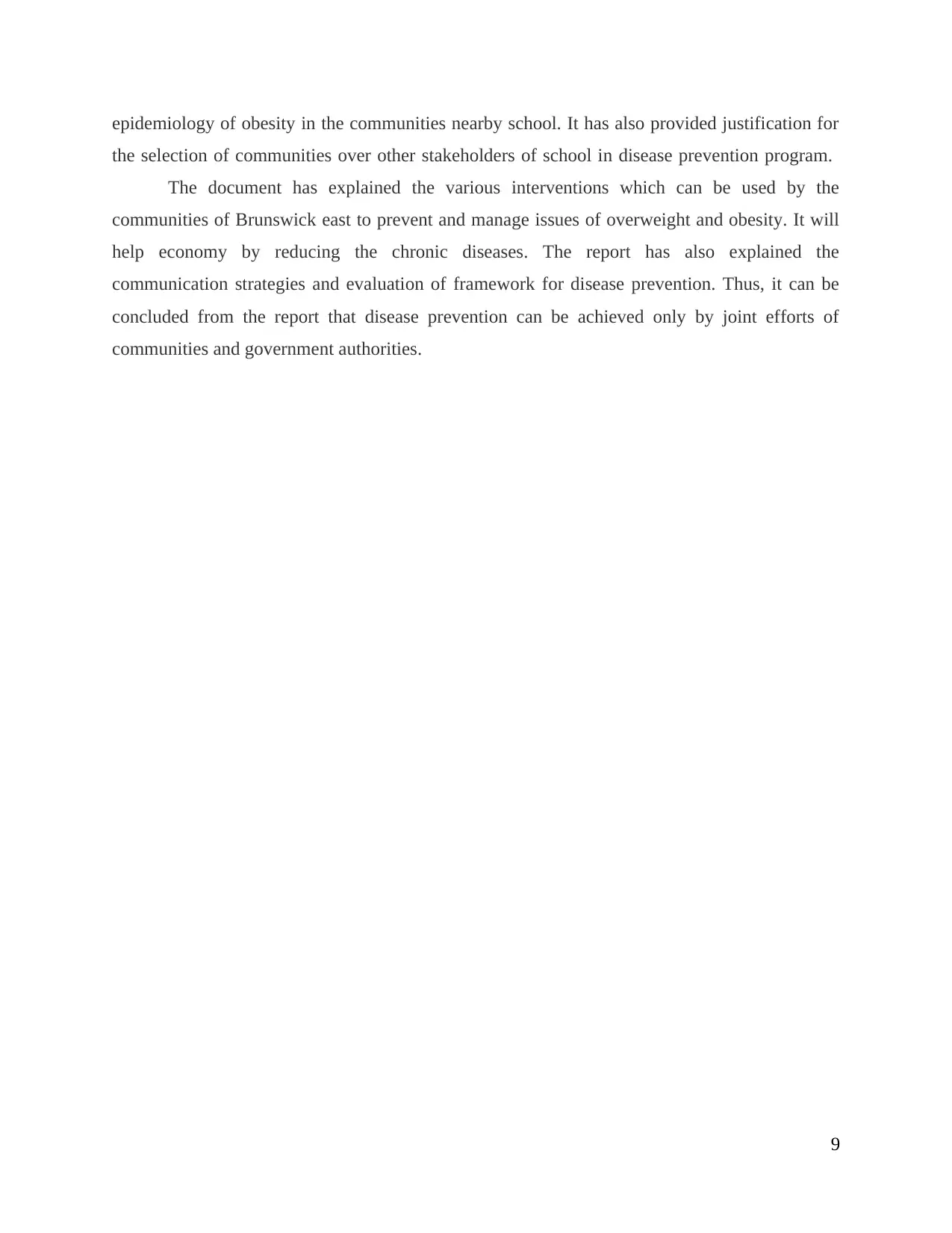
epidemiology of obesity in the communities nearby school. It has also provided justification for
the selection of communities over other stakeholders of school in disease prevention program.
The document has explained the various interventions which can be used by the
communities of Brunswick east to prevent and manage issues of overweight and obesity. It will
help economy by reducing the chronic diseases. The report has also explained the
communication strategies and evaluation of framework for disease prevention. Thus, it can be
concluded from the report that disease prevention can be achieved only by joint efforts of
communities and government authorities.
9
the selection of communities over other stakeholders of school in disease prevention program.
The document has explained the various interventions which can be used by the
communities of Brunswick east to prevent and manage issues of overweight and obesity. It will
help economy by reducing the chronic diseases. The report has also explained the
communication strategies and evaluation of framework for disease prevention. Thus, it can be
concluded from the report that disease prevention can be achieved only by joint efforts of
communities and government authorities.
9
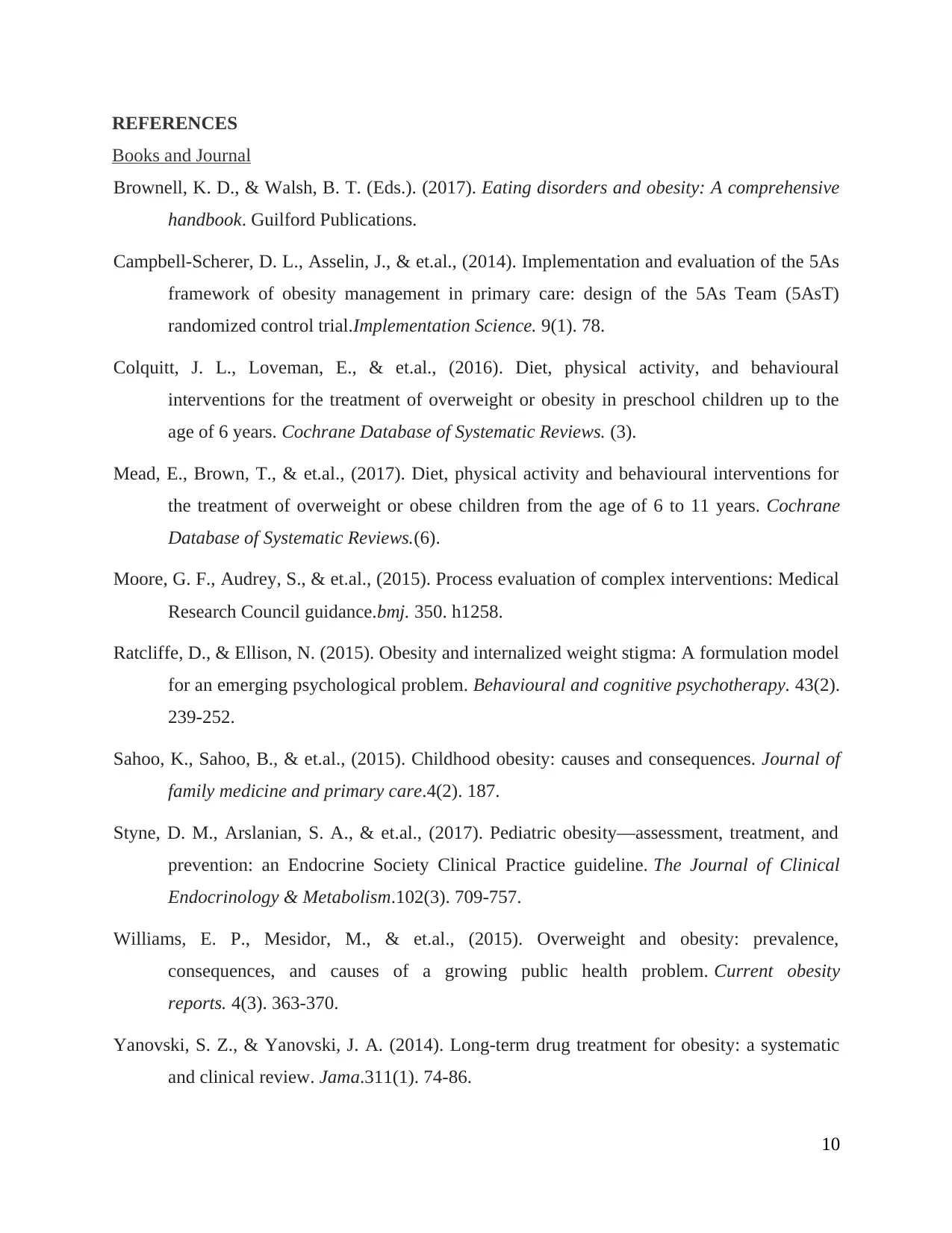
REFERENCES
Books and Journal
Brownell, K. D., & Walsh, B. T. (Eds.). (2017). Eating disorders and obesity: A comprehensive
handbook. Guilford Publications.
Campbell-Scherer, D. L., Asselin, J., & et.al., (2014). Implementation and evaluation of the 5As
framework of obesity management in primary care: design of the 5As Team (5AsT)
randomized control trial.Implementation Science. 9(1). 78.
Colquitt, J. L., Loveman, E., & et.al., (2016). Diet, physical activity, and behavioural
interventions for the treatment of overweight or obesity in preschool children up to the
age of 6 years. Cochrane Database of Systematic Reviews. (3).
Mead, E., Brown, T., & et.al., (2017). Diet, physical activity and behavioural interventions for
the treatment of overweight or obese children from the age of 6 to 11 years. Cochrane
Database of Systematic Reviews.(6).
Moore, G. F., Audrey, S., & et.al., (2015). Process evaluation of complex interventions: Medical
Research Council guidance.bmj. 350. h1258.
Ratcliffe, D., & Ellison, N. (2015). Obesity and internalized weight stigma: A formulation model
for an emerging psychological problem. Behavioural and cognitive psychotherapy. 43(2).
239-252.
Sahoo, K., Sahoo, B., & et.al., (2015). Childhood obesity: causes and consequences. Journal of
family medicine and primary care.4(2). 187.
Styne, D. M., Arslanian, S. A., & et.al., (2017). Pediatric obesity—assessment, treatment, and
prevention: an Endocrine Society Clinical Practice guideline. The Journal of Clinical
Endocrinology & Metabolism.102(3). 709-757.
Williams, E. P., Mesidor, M., & et.al., (2015). Overweight and obesity: prevalence,
consequences, and causes of a growing public health problem. Current obesity
reports. 4(3). 363-370.
Yanovski, S. Z., & Yanovski, J. A. (2014). Long-term drug treatment for obesity: a systematic
and clinical review. Jama.311(1). 74-86.
10
Books and Journal
Brownell, K. D., & Walsh, B. T. (Eds.). (2017). Eating disorders and obesity: A comprehensive
handbook. Guilford Publications.
Campbell-Scherer, D. L., Asselin, J., & et.al., (2014). Implementation and evaluation of the 5As
framework of obesity management in primary care: design of the 5As Team (5AsT)
randomized control trial.Implementation Science. 9(1). 78.
Colquitt, J. L., Loveman, E., & et.al., (2016). Diet, physical activity, and behavioural
interventions for the treatment of overweight or obesity in preschool children up to the
age of 6 years. Cochrane Database of Systematic Reviews. (3).
Mead, E., Brown, T., & et.al., (2017). Diet, physical activity and behavioural interventions for
the treatment of overweight or obese children from the age of 6 to 11 years. Cochrane
Database of Systematic Reviews.(6).
Moore, G. F., Audrey, S., & et.al., (2015). Process evaluation of complex interventions: Medical
Research Council guidance.bmj. 350. h1258.
Ratcliffe, D., & Ellison, N. (2015). Obesity and internalized weight stigma: A formulation model
for an emerging psychological problem. Behavioural and cognitive psychotherapy. 43(2).
239-252.
Sahoo, K., Sahoo, B., & et.al., (2015). Childhood obesity: causes and consequences. Journal of
family medicine and primary care.4(2). 187.
Styne, D. M., Arslanian, S. A., & et.al., (2017). Pediatric obesity—assessment, treatment, and
prevention: an Endocrine Society Clinical Practice guideline. The Journal of Clinical
Endocrinology & Metabolism.102(3). 709-757.
Williams, E. P., Mesidor, M., & et.al., (2015). Overweight and obesity: prevalence,
consequences, and causes of a growing public health problem. Current obesity
reports. 4(3). 363-370.
Yanovski, S. Z., & Yanovski, J. A. (2014). Long-term drug treatment for obesity: a systematic
and clinical review. Jama.311(1). 74-86.
10
⊘ This is a preview!⊘
Do you want full access?
Subscribe today to unlock all pages.

Trusted by 1+ million students worldwide
1 out of 13
Related Documents
Your All-in-One AI-Powered Toolkit for Academic Success.
+13062052269
info@desklib.com
Available 24*7 on WhatsApp / Email
![[object Object]](/_next/static/media/star-bottom.7253800d.svg)
Unlock your academic potential
Copyright © 2020–2025 A2Z Services. All Rights Reserved. Developed and managed by ZUCOL.





